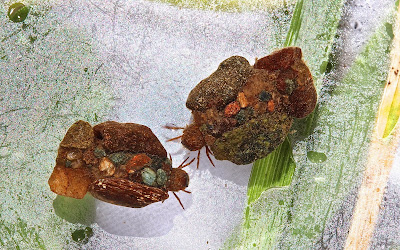This is material I've covered before. But since we've started finding Goerids (Weighted-case maker caddisflies) it's probably worth the review.
When Glenn Wiggins published his Larvae of the North American Caddisfly Genera (Trichoptera) in 1977 (University of Toronto Press), he noted that the Limnephilidae family embraced a total of 52 genera. "The Limnephilidae are the largest family of the Trichoptera in North America, with more than 300 species now assigned to 52 genera. The group is dominant at higher latitudes and elevations through much of the northern hemisphere." (p. 179) When the 2nd edition of that book came out in 1996 the genera number had dropped to 39. Between 1977 and 1996, 15 genera (should be 13 genera??) were removed from Limnephilidae and grouped together creating 4 new families. It worked out this way.
1. family, Apataniidae, composed of the former Limnephilid genera: Allomyia (formerly Imania), Apatania, Manophylax, Moselyana, and Pedomoecus
2. family, Goeridae, composed of the former Limnephilid genera: Goera, Goeracea, Goerita, and Lepania
3. family Rossianidae, composed of the former Limnephilid genera: Goereilla, and Rossiana
and
4. family Uenoidae, composed of the former Limnephilid genera: Farula, Neothremma, Neophylax, Oligophlebodes -- and a new genus, Sericostriata
These families are related as Wiggins points out in Caddisflies: the Underwater Architects (Toronto, 2004): "Morphological characters in the family key to larvae lead to the limnephilid complex of related families: Apataniidae, Goeridae, Rossianidae, Uenoidae, and Limnephilidae -- and cases of rock fragments are constructed in all of them. However, among these families, only larvae in the Limnephilidae construct cases of plant materials, including woody detritus."
Note: all larvae in this "complex" have dorsal and lateral "humps" and prosternal horns.
__________________
Of the current Limnephilid genera (Northern Case-makers), I've only seen one, so far, in a regular way --Pycnopsyche -- and I've seen two different species: Pycnopsyche gentilis,
and Pycnopsyche scabripennis. (Two of many types of "woody" cases.)
________________
Of the 4 new families -- we will not see Rossianidae in the East: the genera that make up that family are only found in the West. But we do see Apataniidae, Goeridae, and Uenoidae -- at least, in each case, the most common genus: Apatania, Goera, and Neophylax (Neophylax is the only Uenoid genus that occurs in the East).
Apatania (Apatania incerta)
Goera (Goera calcarata and Goera fuscula)
Neophylax (N. consimilis and N. mitchelli -- N. aniqua at the top of the page)
Today, not much at Buck Mt. Creek -- but the C. clio Perlodids and the small winter stoneflies are getting bigger.














No comments:
Post a Comment